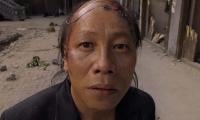Black Lives Matter campaigners target Gandhi statues in UK
LONDON: Anti-racism campaigners in Britain have called on the British government to remove statues of Mahatma Gandhi from two major locations in London and Leicester as Black Lives Matter movement gathers nationwide support for the dismantling of portraits and statues of historic figures who have expressed hatred and racism towards Black people.
Thousands of people are demanding the removal of controversial monuments and statues around the UK, which campaigners describe as "racist and unwelcoming" and that campaign has brought focus on Gandhi who is viewed as a racist who publicly expressed racist views for Black people.
In the last week during large scale protests against racism in the UK, Black Lives Matter protesters vandalised Mahatma Gandhi’s statue in Parliament Square, London, daubing “racist” on the pedestal steps and throwing white paint on the burnished bronze. Authorities fear that the Gandhi statue will come under sustained attack by protestors in coming days. It was previously daubed to mock India by Sikh protestors during demonstrations held in the Square, but the Black Lives Matter movement has encouraged anti-Gandhi campaigners to start their campaign afresh.
The Sikh Federation UK commented on Twitter: Are statues of Mahatma Gandhi across the globe under threat during #BLM protests due to his well-documented anti-black racism views. He referred to Africans as ‘savages’, ‘uncivilised’, ‘dirty’ & ‘like animals’. His comments are vile.
The Gandhi statue, installed in 2015, is one among 12 in the square of prominent British, Commonwealth and foreign political figures, such as Abraham Lincoln and Nelson Mandela. Winston Churchill’s statue was also targeted, with the words sprayed on it: ‘was a racist’.
Since the tragic death of George Floyd in America, a number of petitions are circling online which have taken inspiration from an anti-racism demonstration in Bristol, which saw protesters topple the statue of slave trader Edward Colston before dragging and heaving the bronze monument into the harbour. Petitions are calling on the British government authorities to remove controversial monuments in the UK.
Most of these petitions are demanding removals of English men who were involved in slave trade, anti-Black, racist or monuments depicting Black people in racist ways.
A petition by British Indian campaigners calling on the Leicester City Council to remove the statue of Gandhi from the city has been signed by thousands of people - within hours of its publication. The petition states: “Gandhi is a fascist, racist and sexual predator. For years he has been idolised and taught in school curriculum. For a lot of people in my community, he has bought inconsolable suffering against my people. As a result, I do not wish to see a statue and praise of that kind of character. Therefore, I want to take action to remove it. I suggest, conducting your own research on Gandhi and align it with your beliefs before signing this protest. Ultimately, I believe the following three qualities in anybody, despite what may have been achieved within their life, should never be held as an “icon” or inspiration to others. Furthermore, with YOUR help we can all come together to reflect the change we want to see in the world.”
Historians have unanimously stated that Gandhi was racist in his views and looked down upon Black people. South African academics Ashwin Desai and Goolam Vahed spent seven years to write a book about Gandhi covering 1893 to 1914 when Gandhi lived in South Africa and campaigned for the rights of Indian people there.
Desai and Vahed wrote that during his stay in Africa, Gandhi kept the Indian struggle "separate from that of Africans and coloureds even though the latter were also denied political rights on the basis of colour and could also lay claim to being British subjects".
Gandhi, they said, was indifferent to the plight of the indentured, and believed that state power should remain in white hands, and called black Africans Kaffirs, a derogatory term, for a larger part of his stay in the country.
In 1893, Gandhi wrote to the Natal parliament saying that a "general belief seems to prevail in the Colony that the Indians are a little better, if at all, than savages or the Natives of Africa".
In 1904, he wrote to a health officer in Johannesburg that the council "must withdraw Kaffirs" from an unsanitary slum called the "Coolie Location" where a large number of Africans lived alongside Indians.
"About the mixing of the Kaffirs with the Indians, I must confess I feel most strongly."
Gandhi's biographer and grandson Rajmohan Gandhi has said on record that Gandhi was undoubtedly "at times ignorant and prejudiced about South Africa's blacks".
Ramachandra Guha, writer of the magisterial Gandhi Before India, has written: “Gandhi believed in the Aryan brotherhood. This involved whites and Indians higher up than Africans on the civilised scale. To that extent he was a racist.”
Historian Patrick French wrote in 2013 that "Gandhi's blanking of Africans is the black hole at the heart of his saintly mythology".
Gandhi’s statue in Leicester was also vandalized a few years ago with graffiti appearing to refer to the 1984 Golden Temple attack in India. "Never forget 84" and "We want justice #84" were sprayed on the base of the statue in Leicester's Golden Mile.
The storming of the Golden Temple, codenamed Operation Blue Star, was the start of the 1984 Sikh Genocide and began a concerted campaign for an independent Sikh homeland - called Khalistan.
-
 Prince Harry Arrives In UK To Fight His Phone Hacking Case
Prince Harry Arrives In UK To Fight His Phone Hacking Case -
 Nick Jonas Attempts To Take Break From Jonas Brothers With Upcoming Solo Album?
Nick Jonas Attempts To Take Break From Jonas Brothers With Upcoming Solo Album? -
 Hayden Panettiere Gets Candid About Putting Life Story On Paper
Hayden Panettiere Gets Candid About Putting Life Story On Paper -
 'Ted Lasso' Star Reveals Real Wish For Season Four Story
'Ted Lasso' Star Reveals Real Wish For Season Four Story -
 Peter Claffey 'just Hoping' For THIS Ahead Of 'Game Of Thrones' Spinoffa
Peter Claffey 'just Hoping' For THIS Ahead Of 'Game Of Thrones' Spinoffa -
 Sophie Turner Reflects On Life After Motherhood: 'Really Nice'
Sophie Turner Reflects On Life After Motherhood: 'Really Nice' -
 Royal Expert Makes Bombshell Claim On How Late Queen Tried To Protect Andrew
Royal Expert Makes Bombshell Claim On How Late Queen Tried To Protect Andrew -
 81-year-old Florida Woman Arrested After Chilling Murder Plot
81-year-old Florida Woman Arrested After Chilling Murder Plot -
 Cardi B Scores Major Earn Against Offset In Legal Battle
Cardi B Scores Major Earn Against Offset In Legal Battle -
 Bella Hadid Gets Honest About Receiving Support From 'The Beauty' Co-stars
Bella Hadid Gets Honest About Receiving Support From 'The Beauty' Co-stars -
 Nobel Foundation Reaffirms Its Core Responsibility To ‘safeguard The Dignity Of The Nobel Prizes’
Nobel Foundation Reaffirms Its Core Responsibility To ‘safeguard The Dignity Of The Nobel Prizes’ -
 Prince William, Kate Middleton Warned Of Meghan Markle’s UK Return
Prince William, Kate Middleton Warned Of Meghan Markle’s UK Return -
 Melissa Leo Reveals How Winning An Oscar Made Things Worse
Melissa Leo Reveals How Winning An Oscar Made Things Worse -
 Piers Morgan In Hospital: Here's Why
Piers Morgan In Hospital: Here's Why -
 IPhone 18 Pro Leaked: New Design Reveals Radical Corner Camera Layout
IPhone 18 Pro Leaked: New Design Reveals Radical Corner Camera Layout -
 Kung Fu Legend Siu-Lung Leung Passes Away At 77
Kung Fu Legend Siu-Lung Leung Passes Away At 77



